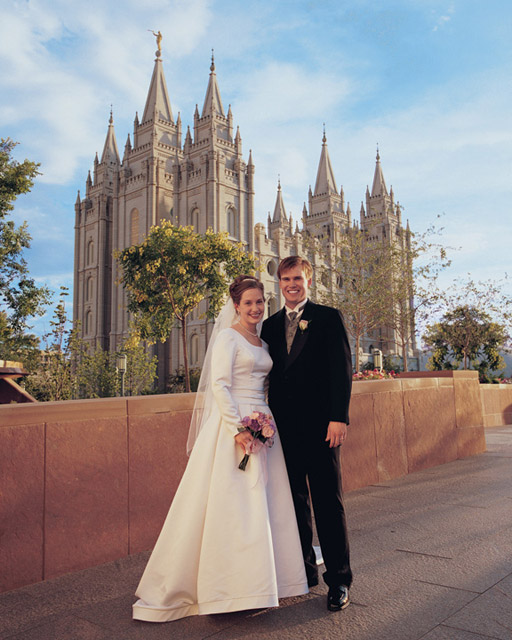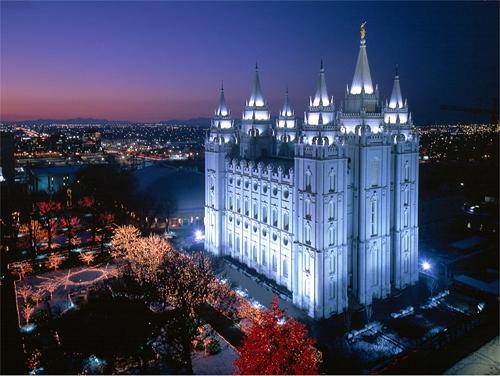Temple Marriages and Family Sealings
 The temple is the House of the Lord, and therefore is employed for the most exalted of ordinances. “Sealings” may be performed in the temple to unite husband and wife for “time and all eternity,” as well as to seal children to their parents. Sealings are performed in “sealing rooms” in the temples. Sealing rooms vary in size, according to the number of guests invited to witness the sealing. A sealing room is beautifully and reverently decorated, and has an altar with a kneeling pad at the center of the room. Bride and groom kneel facing each other during the sealing ceremony. Chairs are placed next to the walls for guests, and facing mirrors on the walls allow the bride and groom to see themselves an infinite number of times, symbolizing the eternal covenant. Both bride and groom must be “temple worthy;” that is, they must each hold a “temple recommend” granted after an interview with their bishop and stake president. Worthiness is determined by obedience to the laws of God–chastity, temperance, and virtue are necessary. Worthy individuals keep the “Word of Wisdom,” the health code given by commandment, pay an honest tithe, dress modestly, serve in the Church, profess a believe in God the Father, have a testimony of Christ’s atonement, and believe in the restored church. Only those with a Mormon temple recommend may attend the ceremony as guests. Family sealings are performed for couples who are married already but have not yet been sealed in the temple. Husband and wife come to the temple (with the required recommends) to be sealed to each other, and then their children kneel around the altar with them to be sealed to their parents. Mormons believe that if sealed families continue in worthiness, the marriage and family unit can endure through the eternities, bringing great joy to family members. Mormons believe the highest kingdom in heaven, the realm where God dwells, is comprised of couples who have been sealed together and have continued in worthiness.
The temple is the House of the Lord, and therefore is employed for the most exalted of ordinances. “Sealings” may be performed in the temple to unite husband and wife for “time and all eternity,” as well as to seal children to their parents. Sealings are performed in “sealing rooms” in the temples. Sealing rooms vary in size, according to the number of guests invited to witness the sealing. A sealing room is beautifully and reverently decorated, and has an altar with a kneeling pad at the center of the room. Bride and groom kneel facing each other during the sealing ceremony. Chairs are placed next to the walls for guests, and facing mirrors on the walls allow the bride and groom to see themselves an infinite number of times, symbolizing the eternal covenant. Both bride and groom must be “temple worthy;” that is, they must each hold a “temple recommend” granted after an interview with their bishop and stake president. Worthiness is determined by obedience to the laws of God–chastity, temperance, and virtue are necessary. Worthy individuals keep the “Word of Wisdom,” the health code given by commandment, pay an honest tithe, dress modestly, serve in the Church, profess a believe in God the Father, have a testimony of Christ’s atonement, and believe in the restored church. Only those with a Mormon temple recommend may attend the ceremony as guests. Family sealings are performed for couples who are married already but have not yet been sealed in the temple. Husband and wife come to the temple (with the required recommends) to be sealed to each other, and then their children kneel around the altar with them to be sealed to their parents. Mormons believe that if sealed families continue in worthiness, the marriage and family unit can endure through the eternities, bringing great joy to family members. Mormons believe the highest kingdom in heaven, the realm where God dwells, is comprised of couples who have been sealed together and have continued in worthiness.
Baptisms
The doctrine of baptism for the dead is spoken of in the Bible by the Apostle Paul. Christ taught that the dead continue to live as spirits before resurrection and judgment. These spirits retain the same personalities they had during their mortal lives and have free agency to make choices as well as the ability to learn and progress. In the “spirit world,” the place where the dead go to await resurrection, the gospel is taught to those who never had an opportunity to hear the good news on earth. A spirit who gains a testimony of Christ in the spirit world has no opportunity to be baptized there, since baptism necessitates a physical body to perform the ordinance. The Lord, therefore, has ordained a practice whereby ordinances can be performed by proxy in temples. The spirit is free to decide whether or not to accept the ordinances performed for him. Young Mormon youth can obtain a limited-use temple recommend to perform baptisms for the dead. One of the reasons why the Mormon Church is heavily involved in genealogy and family history is to do baptism for the dead. Baptisms for the dead are performed in the baptistry of the temple, which according to biblical dictates, is below ground. The baptistry is constructed in the same manner as in Solomon’s Temple.
The Endowment
In the Doctrine and Covenants it says,
…and build a house to my name, for the Most High to dwell therein.
For there is not a place found on earth that he may come to and restore again that which was lost unto you, or which he hath taken away, even the fulness of the priesthood.
…for the beginning of the revelations and foundation of Zion, and for the glory, honor, and endowment of all her municipals, are ordained by the ordinance of my holy house, which my people are always commanded to build unto my holy name (Doctrine and Covenants 124:27, 28, 39).
The endowment is a gift of power and protection from the Lord in return for learning of and keeping covenants. These covenants resonate in the covenants made at baptism–to take upon oneself the name of Christ, to keep His commandments, to be chaste and reverent, to be willing to sacrifice worldly things in order to build up His kingdom on earth and prepare for His second coming. The endowment is a review of the Plan of Salvation for the education of the “Saints”. The Plan of Salvation teaches that men existed as spirit children of God before they were born on earth, that Adam’s fall was part of the plan, that the atonement of Christ is the central event of our existence and provides a way for us to overcome sin and qualify to regain God’s presence in order to become like Him. The endowment is also performed by proxy for the dead, as are baptism and sealing ordinances.
ah….
 Mormons are encouraged to attend the temple at least once a month, in areas where there is a temple nearby. This can be challenging for those who do not live near a temple. Some faithful members drive hours or even journey to other countries just to attend the temple. The church is trying to obviate this problem by constructing more temples. Because the temple is a place of refuge from the outside world, Mormons prefer to keep the ordinances and ceremonies performed within the temple private. In fact, Mormons take a vow not to publicize what is done in the temple with anyone. The temple ceremonies are sacred, not secret.
Mormons are encouraged to attend the temple at least once a month, in areas where there is a temple nearby. This can be challenging for those who do not live near a temple. Some faithful members drive hours or even journey to other countries just to attend the temple. The church is trying to obviate this problem by constructing more temples. Because the temple is a place of refuge from the outside world, Mormons prefer to keep the ordinances and ceremonies performed within the temple private. In fact, Mormons take a vow not to publicize what is done in the temple with anyone. The temple ceremonies are sacred, not secret.
Mormons do not attend Sunday meetings in the temple, for those are held in chapels in meeting houses.
